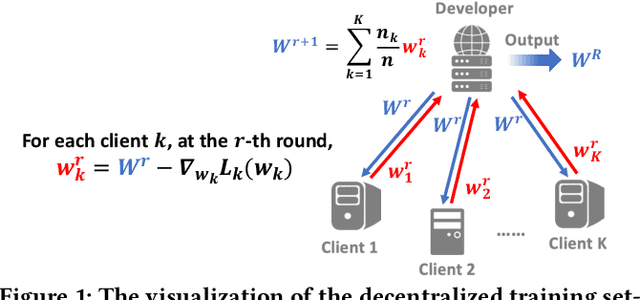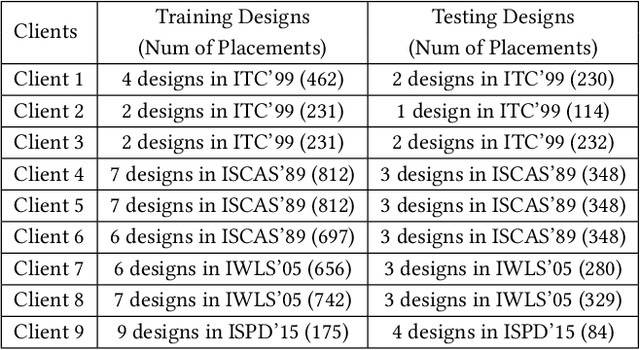Zhiyao Xie
ELF: Efficient Logic Synthesis by Pruning Redundancy in Refactoring
Aug 11, 2025Abstract:In electronic design automation, logic optimization operators play a crucial role in minimizing the gate count of logic circuits. However, their computation demands are high. Operators such as refactor conventionally form iterative cuts for each node, striving for a more compact representation - a task which often fails 98% on average. Prior research has sought to mitigate computational cost through parallelization. In contrast, our approach leverages a classifier to prune unsuccessful cuts preemptively, thus eliminating unnecessary resynthesis operations. Experiments on the refactor operator using the EPFL benchmark suite and 10 large industrial designs demonstrate that this technique can speedup logic optimization by 3.9x on average compared with the state-of-the-art ABC implementation.
GenEDA: Unleashing Generative Reasoning on Netlist via Multimodal Encoder-Decoder Aligned Foundation Model
Apr 13, 2025Abstract:The success of foundation AI has motivated the research of circuit foundation models, which are customized to assist the integrated circuit (IC) design process. However, existing pre-trained circuit models are typically limited to standalone encoders for predictive tasks or decoders for generative tasks. These two model types are developed independently, operate on different circuit modalities, and reside in separate latent spaces, which restricts their ability to complement each other for more advanced applications. In this work, we present GenEDA, the first framework that aligns circuit encoders with decoders within a shared latent space. GenEDA bridges the gap between graph-based circuit representations and text-based large language models (LLMs), enabling communication between their respective latent spaces. To achieve the alignment, we propose two paradigms that support both open-source trainable LLMs and commercial frozen LLMs. Built on this aligned architecture, GenEDA enables three unprecedented generative reasoning tasks over netlists, where the model reversely generates the high-level functionality from low-level netlists in different granularities. These tasks extend traditional gate-type prediction to direct generation of full-circuit functionality. Experiments demonstrate that GenEDA significantly boosts advanced LLMs' (e.g., GPT-4o and DeepSeek-V3) performance in all tasks.
NetTAG: A Multimodal RTL-and-Layout-Aligned Netlist Foundation Model via Text-Attributed Graph
Apr 12, 2025Abstract:Circuit representation learning has shown promise in advancing Electronic Design Automation (EDA) by capturing structural and functional circuit properties for various tasks. Existing pre-trained solutions rely on graph learning with complex functional supervision, such as truth table simulation. However, they only handle simple and-inverter graphs (AIGs), struggling to fully encode other complex gate functionalities. While large language models (LLMs) excel at functional understanding, they lack the structural awareness for flattened netlists. To advance netlist representation learning, we present NetTAG, a netlist foundation model that fuses gate semantics with graph structure, handling diverse gate types and supporting a variety of functional and physical tasks. Moving beyond existing graph-only methods, NetTAG formulates netlists as text-attributed graphs, with gates annotated by symbolic logic expressions and physical characteristics as text attributes. Its multimodal architecture combines an LLM-based text encoder for gate semantics and a graph transformer for global structure. Pre-trained with gate and graph self-supervised objectives and aligned with RTL and layout stages, NetTAG captures comprehensive circuit intrinsics. Experimental results show that NetTAG consistently outperforms each task-specific method on four largely different functional and physical tasks and surpasses state-of-the-art AIG encoders, demonstrating its versatility.
ShortCircuit: AlphaZero-Driven Circuit Design
Aug 19, 2024



Abstract:Chip design relies heavily on generating Boolean circuits, such as AND-Inverter Graphs (AIGs), from functional descriptions like truth tables. While recent advances in deep learning have aimed to accelerate circuit design, these efforts have mostly focused on tasks other than synthesis, and traditional heuristic methods have plateaued. In this paper, we introduce ShortCircuit, a novel transformer-based architecture that leverages the structural properties of AIGs and performs efficient space exploration. Contrary to prior approaches attempting end-to-end generation of logic circuits using deep networks, ShortCircuit employs a two-phase process combining supervised with reinforcement learning to enhance generalization to unseen truth tables. We also propose an AlphaZero variant to handle the double exponentially large state space and the sparsity of the rewards, enabling the discovery of near-optimal designs. To evaluate the generative performance of our trained model , we extract 500 truth tables from a benchmark set of 20 real-world circuits. ShortCircuit successfully generates AIGs for 84.6% of the 8-input test truth tables, and outperforms the state-of-the-art logic synthesis tool, ABC, by 14.61% in terms of circuits size.
Accel-NASBench: Sustainable Benchmarking for Accelerator-Aware NAS
Apr 09, 2024Abstract:One of the primary challenges impeding the progress of Neural Architecture Search (NAS) is its extensive reliance on exorbitant computational resources. NAS benchmarks aim to simulate runs of NAS experiments at zero cost, remediating the need for extensive compute. However, existing NAS benchmarks use synthetic datasets and model proxies that make simplified assumptions about the characteristics of these datasets and models, leading to unrealistic evaluations. We present a technique that allows searching for training proxies that reduce the cost of benchmark construction by significant margins, making it possible to construct realistic NAS benchmarks for large-scale datasets. Using this technique, we construct an open-source bi-objective NAS benchmark for the ImageNet2012 dataset combined with the on-device performance of accelerators, including GPUs, TPUs, and FPGAs. Through extensive experimentation with various NAS optimizers and hardware platforms, we show that the benchmark is accurate and allows searching for state-of-the-art hardware-aware models at zero cost.
PANDA: Architecture-Level Power Evaluation by Unifying Analytical and Machine Learning Solutions
Dec 14, 2023Abstract:Power efficiency is a critical design objective in modern microprocessor design. To evaluate the impact of architectural-level design decisions, an accurate yet efficient architecture-level power model is desired. However, widely adopted data-independent analytical power models like McPAT and Wattch have been criticized for their unreliable accuracy. While some machine learning (ML) methods have been proposed for architecture-level power modeling, they rely on sufficient known designs for training and perform poorly when the number of available designs is limited, which is typically the case in realistic scenarios. In this work, we derive a general formulation that unifies existing architecture-level power models. Based on the formulation, we propose PANDA, an innovative architecture-level solution that combines the advantages of analytical and ML power models. It achieves unprecedented high accuracy on unknown new designs even when there are very limited designs for training, which is a common challenge in practice. Besides being an excellent power model, it can predict area, performance, and energy accurately. PANDA further supports power prediction for unknown new technology nodes. In our experiments, besides validating the superior performance and the wide range of functionalities of PANDA, we also propose an application scenario, where PANDA proves to identify high-performance design configurations given a power constraint.
EDALearn: A Comprehensive RTL-to-Signoff EDA Benchmark for Democratized and Reproducible ML for EDA Research
Dec 04, 2023Abstract:The application of Machine Learning (ML) in Electronic Design Automation (EDA) for Very Large-Scale Integration (VLSI) design has garnered significant research attention. Despite the requirement for extensive datasets to build effective ML models, most studies are limited to smaller, internally generated datasets due to the lack of comprehensive public resources. In response, we introduce EDALearn, the first holistic, open-source benchmark suite specifically for ML tasks in EDA. This benchmark suite presents an end-to-end flow from synthesis to physical implementation, enriching data collection across various stages. It fosters reproducibility and promotes research into ML transferability across different technology nodes. Accommodating a wide range of VLSI design instances and sizes, our benchmark aptly represents the complexity of contemporary VLSI designs. Additionally, we provide an in-depth data analysis, enabling users to fully comprehend the attributes and distribution of our data, which is essential for creating efficient ML models. Our contributions aim to encourage further advances in the ML-EDA domain.
RTLLM: An Open-Source Benchmark for Design RTL Generation with Large Language Model
Aug 10, 2023Abstract:Inspired by the recent success of large language models (LLMs) like ChatGPT, researchers start to explore the adoption of LLMs for agile hardware design, such as generating design RTL based on natural-language instructions. However, in existing works, their target designs are all relatively simple and in a small scale, and proposed by the authors themselves, making a fair comparison among different LLM solutions challenging. In addition, many prior works only focus on the design correctness, without evaluating the design qualities of generated design RTL. In this work, we propose an open-source benchmark named RTLLM, for generating design RTL with natural language instructions. To systematically evaluate the auto-generated design RTL, we summarized three progressive goals, named syntax goal, functionality goal, and design quality goal. This benchmark can automatically provide a quantitative evaluation of any given LLM-based solution. Furthermore, we propose an easy-to-use yet surprisingly effective prompt engineering technique named self-planning, which proves to significantly boost the performance of GPT-3.5 in our proposed benchmark.
Intelligent Circuit Design and Implementation with Machine Learning
Jun 07, 2022



Abstract:The stagnation of EDA technologies roots from insufficient knowledge reuse. In practice, very similar simulation or optimization results may need to be repeatedly constructed from scratch. This motivates my research on introducing more 'intelligence' to EDA with machine learning (ML), which explores complex correlations in design flows based on prior data. Besides design time, I also propose ML solutions to boost IC performance by assisting the circuit management at runtime. In this dissertation, I present multiple fast yet accurate ML models covering a wide range of chip design stages from the register-transfer level (RTL) to sign-off, solving primary chip-design problems about power, timing, interconnect, IR drop, routability, and design flow tuning. Targeting the RTL stage, I present APOLLO, a fully automated power modeling framework. It constructs an accurate per-cycle power model by extracting the most power-correlated signals. The model can be further implemented on chip for runtime power management with unprecedented low hardware costs. Targeting gate-level netlist, I present Net2 for early estimations on post-placement wirelength. It further enables more accurate timing analysis without actual physical design information. Targeting circuit layout, I present RouteNet for early routability prediction. As the first deep learning-based routability estimator, some feature-extraction and model-design principles proposed in it are widely adopted by later works. I also present PowerNet for fast IR drop estimation. It captures spatial and temporal information about power distribution with a customized CNN architecture. Last, besides targeting a single design step, I present FIST to efficiently tune design flow parameters during both logic synthesis and physical design.
Towards Collaborative Intelligence: Routability Estimation based on Decentralized Private Data
Mar 30, 2022



Abstract:Applying machine learning (ML) in design flow is a popular trend in EDA with various applications from design quality predictions to optimizations. Despite its promise, which has been demonstrated in both academic researches and industrial tools, its effectiveness largely hinges on the availability of a large amount of high-quality training data. In reality, EDA developers have very limited access to the latest design data, which is owned by design companies and mostly confidential. Although one can commission ML model training to a design company, the data of a single company might be still inadequate or biased, especially for small companies. Such data availability problem is becoming the limiting constraint on future growth of ML for chip design. In this work, we propose an Federated-Learning based approach for well-studied ML applications in EDA. Our approach allows an ML model to be collaboratively trained with data from multiple clients but without explicit access to the data for respecting their data privacy. To further strengthen the results, we co-design a customized ML model FLNet and its personalization under the decentralized training scenario. Experiments on a comprehensive dataset show that collaborative training improves accuracy by 11% compared with individual local models, and our customized model FLNet significantly outperforms the best of previous routability estimators in this collaborative training flow.
 Add to Chrome
Add to Chrome Add to Firefox
Add to Firefox Add to Edge
Add to Edge